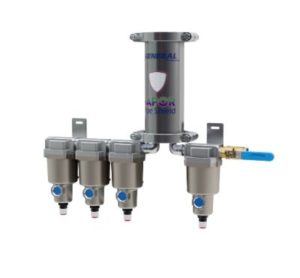 Released in 2023, Vapor Pipe Shield is UL Listed for use in dry and pre-action fire sprinkler systems and is steadily gaining acceptance.
Released in 2023, Vapor Pipe Shield is UL Listed for use in dry and pre-action fire sprinkler systems and is steadily gaining acceptance.
Dry pipe fire sprinkler systems are critical to fire protection strategies in areas subject to freezing temperatures and sensitive areas such as hospitals, museums, data centres, or any facility where sprinkler pipes are left unfilled due to the prospect of water leaking on delicate artifacts and equipment.
Preventing corrosion inside these systems is critical to maintaining reliability and reducing the risk of costly sprinkler pipe replacements, frequent repairs, and—worse yet—failure.
According to an article on “Nitrogen Generators for Dry Pipe Systems” by Mark Hopkins, Engineering Director at Summit Fire Consulting, an industry practice for corrosion protection over the last 15 years has been to purge as much oxygen as possible out of a sprinkler system using a nitrogen generator.
Hopkins explained that this method falls within the NFPA 13 Standard for the Installation of Sprinkler Systems and (at 98 percent purity) and allows contractors to use the Hazen-Williams C-Value of 120 for hydraulic calculations.
However, maintaining the necessary level of 98 percent nitrogen purity has proven to be challenging in published testing.
To compare the effectiveness of Cortec® VpCI® (used in Vapor Pipe Shield) against compressed air (simulating untreated systems) and 98% nitrogen, General Air Products commissioned Corrosion Testing Laboratories, Inc., to conduct five years of testing on the subject.
The first year of test data was released in December 2024, indicating that VpCI protection was up to seven times more effective on carbon steel coupons partially submerged in water than the protection of 98 percent nitrogen.
Now, in the newly released version (2025 edition) of NFPA 13, the 120 C-Factor allowance has been extended to Vapor phase Corrosion Inhibitor delivery systems including Vapor Pipe Shield. This important change validates the effectiveness of Vapor Pipe Shield to inhibit corrosion in these systems and its rapid adoption by the fire protection industry.
VpCI® is extremely easy to apply and requires little maintenance. Unlike a standalone nitrogen generator, the delivery system is not dependent on a source of electricity. It is thorough, protecting in the liquid phase, vapor phase, and at the air-water interface, diffusing even into hard-to-reach areas like branch lines.
Ray Fremont Jr., President of General Air Products, recently noted, “Since launching Vapor Pipe Shield in March 2023, we’ve seen tremendous adoption across North America, with over 500 installations to date. That milestone speaks not only to the effectiveness of VpCI® technology but also to its growing recognition as a game-changer for corrosion mitigation in dry and pre-action fire sprinkler systems.”
